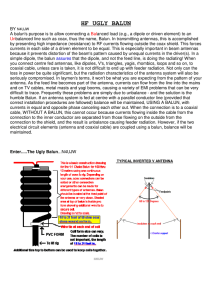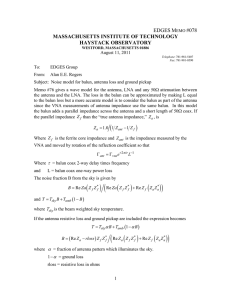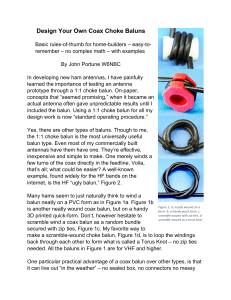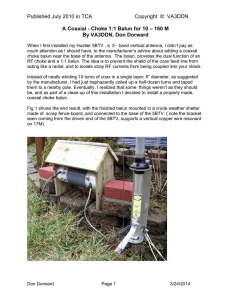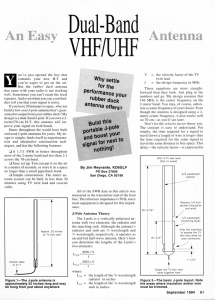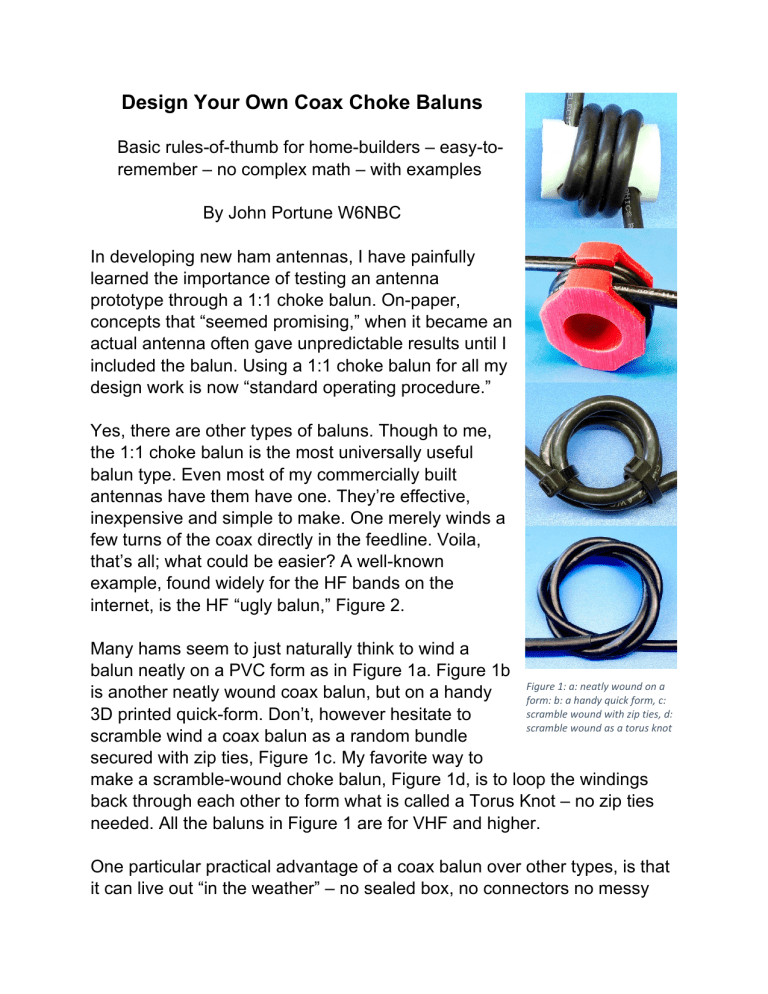
Design Your Own Coax Choke Baluns Basic rules-of-thumb for home-builders – easy-toremember – no complex math – with examples By John Portune W6NBC In developing new ham antennas, I have painfully learned the importance of testing an antenna prototype through a 1:1 choke balun. On-paper, concepts that “seemed promising,” when it became an actual antenna often gave unpredictable results until I included the balun. Using a 1:1 choke balun for all my design work is now “standard operating procedure.” Yes, there are other types of baluns. Though to me, the 1:1 choke balun is the most universally useful balun type. Even most of my commercially built antennas have them have one. They’re effective, inexpensive and simple to make. One merely winds a few turns of the coax directly in the feedline. Voila, that’s all; what could be easier? A well-known example, found widely for the HF bands on the internet, is the HF “ugly balun,” Figure 2. Many hams seem to just naturally think to wind a balun neatly on a PVC form as in Figure 1a. Figure 1b Figure 1: a: neatly wound on a is another neatly wound coax balun, but on a handy form: b: a handy quick form, c: scramble wound with zip ties, d: 3D printed quick-form. Don’t, however hesitate to scramble wound as a torus knot scramble wind a coax balun as a random bundle secured with zip ties, Figure 1c. My favorite way to make a scramble-wound choke balun, Figure 1d, is to loop the windings back through each other to form what is called a Torus Knot – no zip ties needed. All the baluns in Figure 1 are for VHF and higher. One particular practical advantage of a coax balun over other types, is that it can live out “in the weather” – no sealed box, no connectors no messy tape or sealants. Yes, coax baluns can be large. Some may consider them ugly, but they are effective for a very wide range of balun applications. Most important to many is that they and are easy to make and inexpensive. Let’s now see how to build one. First you need to choose one of the buildit-yourself methods above. Next you need to determine the number of turns and the diameter of the coil for a given band. Some may consider this difficult; it isn’t. Fortunately, three easy-to-remember math-free rules-ofthumb that will get you there. The Starting Point The first derives from the primary responsibility of ALL baluns: to keep transmitter RF inside the feed coax. Baluns can also serve other functions other than choking off shield RF, but that is the important one. RF being carried by coax should exist ONLY between the outside surface of center conductor and the inside surface of the shield or braid. It should not be allowed to find its way onto the outside surface of the coax, where it is technically known as common-mode current. Failure to realize the importance of this fundamental reason for a balun ultimately forced me to begin using a 1:1 choke balun during antenna development. Commonmode current (RF on the shield), before then had been keeping me from seeing the performance I knew should be there. Stopping Common-Mode Current A choke balun stops RF on the shield by introducing an impedance (more technically a reactance) in series with the outside of the shield. Any common-mode current will then be choked off when it encounters the coil’s reactance. The amount of reactance must be relatively high in comparison to the working (characteristic) impedance of the antenna system – 50 Ohms in most ham situations. Standard engineering practice suggests that a reactance be at a minimum of four times the system impedance, or 200 Ohms, is enough. Coax Choke Balun Rule-of-thumb 1: The coax choke coil must have a reactance of at least 200 Ohms in a 50 Ohm antenna system, at the frequency of operation. You can make it larger, but 200 Ohms is a satisfactory starting point. Many published designs suggest more, and that is fine. Translating Coil Reactance into Windings Coax Choke Balun Rule-of-thumb 2: (1) convert Ohms to Microhenries and then (2) convert Microhenries to turns and coil diameter. Most RF handbooks have the math formulas to do both. I find on-line calculators much easier. Here, without endorsement, are the two that I use. (1) Reactance to inductance: https://www.electronics2000.co.uk/calc/reactance-calculator.php (2) Inductance to turns and coax coil diameter https://www.allaboutcircuits.com/tools/coil-inductance-calculator Let’s now look at two practical examples. Try the the two steps with the calculators for yourself; the process is straight forward. Example 1: A 2 Meter 1:1 Coax Choke Balun Calculator (1) translates the 200 Ohms of reactance at 146 MHz to 0.22 µH of inductance. Calculator (2) next translates 0.22 µH of inductance into 3 turns of 0.2 in. diameter coax (RG-58 or LMR-200) on a 1 in. diameter form. This balun seen in Figure 1b, wound on a handy 3D-printed quick form. The 3D printer file (.stl ) for this coil form is available free for download at w6nbc.com/3d and arrl.org/qst-in-depth. Example 2: A 160 Meter and Higher 1:1 Coax Choke Balun Calculator (1) computes that a reactance of 200 Ohms at 1.8 MHz needs a coil of 18 µH. Calculator (2) next computes that an 18 µH coil requires a minimum of 12 turns of 0.4 in. diameter coax (RG-8 or LMR-400) coil wound on a 5 in. diameter Schedule 40 PVC form. See Figure 2. Shown is a typical “ugly balun” widely described on the internet in a variety of lengths, diameters and coax types. You may use more inductance if you wish, or more turns and a larger diameter. Many references do. This is fine, as lower frequency balun also works on higher bands. A Word on Scramble Winding Figure 2: The minimum 160m and higher ugly balun. Some may be wondering about randomly winding a coax balun, Figure 1c & 1d. It’s quite okay. A neat coil on a form, Figure 1a, is not essential. Rule-of-Thumb 3: A scramble-wound coil has less inductance than a neatly-wound coil. Studies suggest de-rating a scramble-wound coil by roughly 40%. As a fan of home-brew ham antennas, my design “mantra” is to now use a balun on ALL antennas, even commercially-build antennas. One might use a 4:1 balun, for example, for the needed impedance transformations in an OCF HF dipole, but for most other balun applications, a simple coiled-coax 1:1 choke balun works very well. I have a good example at my QTH on the SO-239 “unbalanced output” jack of an automatic antenna tuner that feeds a multi-band 20 ft. HF flagpole antenna with 450 Ohm or open-wire window line. A short coax stub with a coiled coax choke balun, connected to the output of the tuner, takes care of both the balance issue and keeping common-mode RF off of the coax run from my rig to the tuner. A 1:1 choke balun, whether in coax or as ferrite cores/beads, to me is the most useful form of the balun. It eliminates unwanted RF on the shield without interfering with what is going on inside the coax very well for most applications. For antenna development or modification, I now consider one an essential for consistent performance with any antenna. These few rulesof-thumb have become a basic component of my antenna design toolkit.

